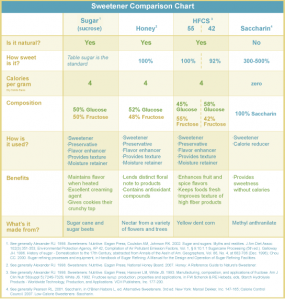High fructose corn syrup (HFCS), a sweetener made from corn, comes in two primary compositions—HFCS-42 and HFCS-55. This means it is composed of either 42 percent or 55 percent fructose, with the remaining sugars being primarily glucose and higher sugars (chains of glucose).
In terms of composition, high fructose corn syrup is nearly identical to table sugar (sucrose), which is composed of 50 percent fructose and 50 percent glucose. Glucose is one of the simplest forms of sugar that serves as a building block for most carbohydrates. Fructose is a simple sugar commonly found in fruits and honey.
A simple comparison of the percentage of glucose and fructose reveals its similarities to table sugar.
· HFCS-42 = 42% fructose + 58% glucose
· HFCS-55 = 55% fructose + 45% glucose
· Table sugar = 50% fructose and 50% glucose
Myths vs. Facts
You’ve probably seen the negative headlines about high fructose corn syrup. Here are some of the most common inaccurate statements about this misunderstood sweetener along with the actual reality.
Myth: High fructose corn syrup is to blame for obesity.
Fact: Obesity is caused by consuming more calories than are expended and Type II diabetes is associated with obesity. While high fructose corn syrup contributes to calories in the diet, there is no scientific evidence that high fructose corn syrup is a unique contributor to obesity or diabetes. In fact, the U.S. Department of Agriculture data shows that consumption of high fructose corn syrup has actually been declining while obesity and diabetes rates continued to rise. Around the world, obesity levels are also rising even though HFCS consumption is limited outside of the U.S. Many other factors contribute to rising obesity levels including changes in lifestyle, diet and exercise and are unrelated to HFCS
.
Myth: High fructose corn syrup is sweeter than sugar.
Fact: Sorry, no. High fructose corn syrup and sugar (sucrose) have almost the same level of sweetness. HFCS was made to provide the same sweetness as sugar (sucrose) so that consumers would not notice a difference in sweetness or taste. In fact, one type of HFCS commonly used in foods (HFCS-42) is actually less sweet than sugar.
FAQs
How do sugars affect my body?
Sugars give you energy in the form of calories and provide building blocks for other molecules your body needs such as proteins and fats.
What benefits does HFCS provide other than sweetness?
· Provide texture and enhance “mouth-feel”
· Act as preservatives that protect the flavor, aroma and color of fruit used in jellies, jams and preserves
· Help brown baked foods
· Provide fermentable sugars that help bread rise
· Retain moisture so high fiber products taste better and baked goods stay fresh
· Contribute to the bulk or volume of ice cream
· Reduce the harsh vinegar or acid bite in non-sweet foods such as salad dressings, sauces and condiments
· Control freezing, melting and boiling points of products
Comparing Sweeteners
Here’s a quick, side-by-side look at some of the most common types of sweeteners you find on nutrition labels:

Key Points About High Fructose Corn Syrup
· The American Medical Association stated in June 2008 that “…high fructose syrup does not appear to contribute to obesity more than other caloric sweeteners…”
· In 1983, the U.S. Food and Drug Administration (FDA) formally listed high fructose corn syrup as safe for use in food and reaffirmed that decision in 1996.
· High fructose corn syrup is not sweeter than sugar; and high fructose corn syrup, sugar and honey all contain the same number of calories (four calories per gram).
· Many confuse pure “fructose” with “high fructose corn syrup.” Recent studies that have examined pure fructose have been inappropriately applied to high fructose corn syrup and have caused significant consumer confusion. High fructose corn syrup never contains fructose alone, but always in combination with a roughly equivalent amount of a second sugar (glucose).

